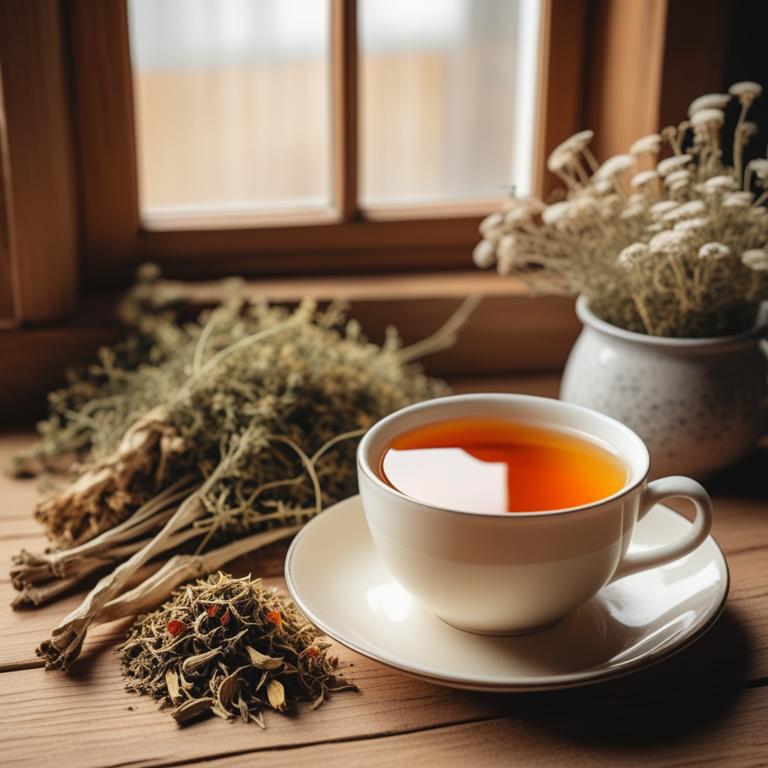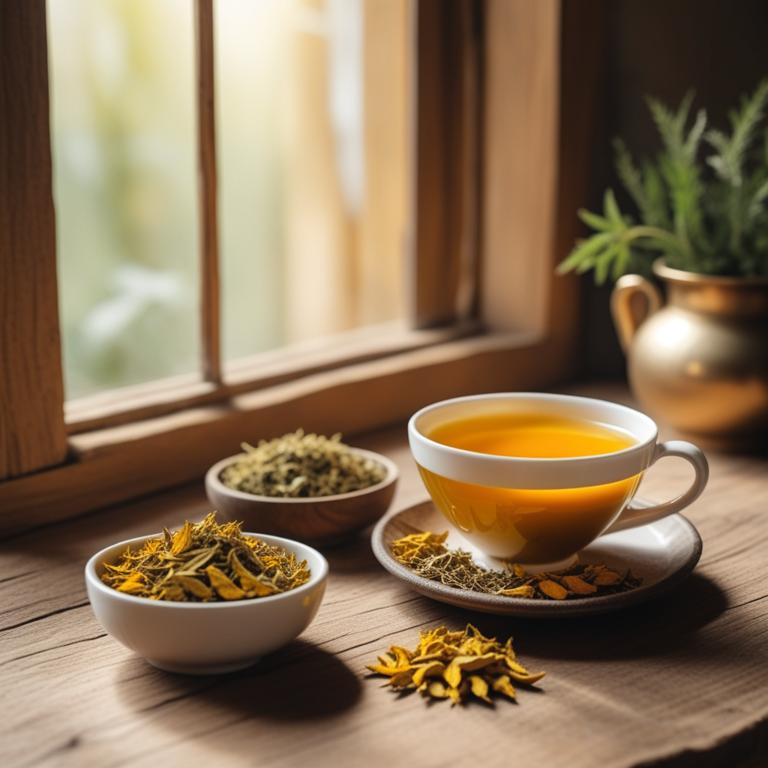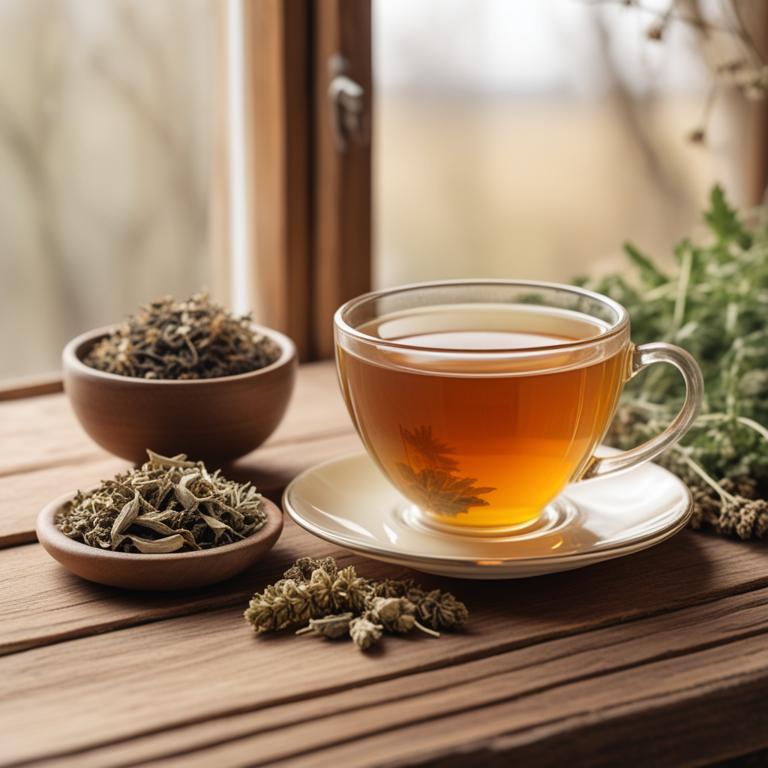10 Herbal Teas For Leg Pain

Herbal teas have been used for centuries to soothe leg pain.
These teas work by reducing inflammation and relaxing the muscles. The main culprits behind leg pain are free radicals and inflammation, which herbal teas help to combat. For example, Zingiber officinale, or ginger, has anti-inflammatory properties that help to reduce swelling and ease pain. Its active compound, gingerol, blocks the production of a chemical that causes pain, making it a popular ingredient in many herbal teas. Ginkgo biloba is another herb used to relieve leg pain. It improves blood flow to the affected area, allowing more oxygen and nutrients to reach the muscles. This helps to reduce pain and inflammation, as well as promote healing.
Curcuma longa, or turmeric, contains a powerful anti-inflammatory compound called curcumin. Curcumin reduces inflammation and pain by blocking the production of enzymes that cause inflammation. When consumed as a tea, these herbs work together to provide fast and effective relief from leg pain. Drinking herbal teas can bring several benefits to your life. Firstly, they are a natural and non-invasive way to manage leg pain. This means you can avoid prescription medication and its potential side effects. Additionally, herbal teas are often caffeine-free and low in calories, making them a healthier alternative to coffee or soda. They can also be consumed hot or cold, depending on your preference, and can be enjoyed at any time of day.
This flexibility allows you to incorporate herbal teas into your daily routine and take control of your leg pain.
- 1. Zingiber officinale
- 2. Ginkgo biloba
- 3. Curcuma longa
- 4. Glycyrrhiza glabra
- 5. Echinacea purpurea
- 6. Achillea millefolium
- 7. Valeriana officinalis
- 8. Ruscus aculeatus
- 9. Cinchona officinalis
- 10. Vitex agnus-castus
1. Zingiber officinale

Zingiber officinale teas contains compounds like gingerol and shogaol, which are responsible for its anti-inflammatory properties.
These compounds help reduce pain and swelling by blocking the production of pain-causing chemicals in the body. The anti-inflammatory properties of Zingiber officinale teas also help relax muscles, which can contribute to leg pain. Additionally, ginger has a warming effect that increases blood flow to the affected area, which can help reduce pain and stiffness.
By reducing inflammation and increasing blood flow, Zingiber officinale teas can help alleviate leg pain.
- Gather 1 tablespoon of fresh Zingiber officinale (Ginger) root and 1 cup of water.
- Peel the ginger root and slice it thinly. You can use a cheese grater for a smoother tea.
- Boil the water in a pot or kettle. Remove from heat when it starts boiling.
- Add the sliced ginger to the boiling water and let it steep for 5-7 minutes. You can adjust the steeping time to your liking.
- Strain the tea into a cup and enjoy. You can add honey or lemon to taste, but be careful not to add too much sugar as it may reduce the benefits of the ginger.
Zingiber Officinale Tea on Amazon
FGO Organic Ginger Tea, 100 Count, Eco-Conscious Tea Bags, Caffeine Free, Packaging May Vary (Pack of 1)
Disclaimer: We earn a commission if you click this link and make a purchase at no additional cost to you.
2. Ginkgo biloba

Ginkgo biloba teas contains bioactive constituents like flavonoids and bilobalide.
These compounds help improve blood circulation by relaxing blood vessels and increasing oxygen delivery to the muscles. As a result, ginkgo biloba teas can help reduce inflammation and alleviate pain in the legs. The flavonoids also have antioxidant properties that help protect the body from oxidative stress, which can contribute to pain and inflammation.
By improving circulation and reducing inflammation, ginkgo biloba teas may help provide relief from leg pain.
- Gather 1 cup of water and 1 teaspoon of dried Ginkgo biloba leaves in a tea infuser or a small muslin bag.
- Heat the water in a pot or kettle until it reaches a boil.
- Pour the hot water over the Ginkgo biloba leaves in the tea infuser or muslin bag.
- Let the mixture steep for 5-7 minutes, then remove the tea infuser or muslin bag.
- Strain the tea into a cup and drink immediately, ideally 2-3 times a day for leg pain relief.
3. Curcuma longa

Curcuma longa teas contains a compound called curcumin, which has potent anti-inflammatory properties.
This compound helps to reduce swelling and pain in the legs by inhibiting the production of inflammatory enzymes called COX-2 and 5-LOX. Curcumin also has antioxidant properties, which help to neutralize free radicals that can cause tissue damage and contribute to pain. Additionally, curcuma longa teas contains other bioactive constituents such as demethoxycurcumin and bisdemethoxycurcumin, which have been shown to have anti-inflammatory and pain-relieving effects.
By reducing inflammation and oxidative stress, Curcuma longa teas may help alleviate leg pain and promote healing.
- Gather 1 teaspoon of dried Curcuma longa root powder and 1 cup of water.
- Heat the water in a saucepan until it starts boiling.
- Reduce heat and add the Curcuma longa root powder to the boiling water.
- Let it simmer for 5-7 minutes, then strain the mixture using a fine-mesh sieve.
- Drink the tea 2-3 times a day for leg pain relief, as needed.
4. Glycyrrhiza glabra

Glycyrrhiza glabra teas contains glycyrrhizin, a key bioactive constituent that has anti-inflammatory properties.
This helps to reduce inflammation and swelling in the muscles and joints, which can contribute to leg pain. Glycyrrhizin also has antioxidant properties, which can help to protect cells from damage and promote healing. The tea's flavonoids, such as isoflavones and flavanols, have anti-inflammatory and antispasmodic effects, which can help to ease muscle spasms and cramps in the legs.
The combination of these compounds in Glycyrrhiza glabra teas may help to alleviate leg pain by reducing inflammation, promoting healing, and relaxing muscle spasms.
- Get 1 cup of boiling water.
- Add 1 teaspoon of dried Glycyrrhiza glabra root to the water.
- Steep for 5-7 minutes to let the root infuse.
- Strain the tea into a cup using a tea strainer or cheesecloth.
- Drink 1-2 cups of the tea per day to help with leg pain relief.
5. Echinacea purpurea

Echinacea purpurea teas contains alkylamides and glycosides as its bioactive constituents.
These compounds help reduce inflammation, which is a common cause of leg pain. The alkylamides in Echinacea purpurea teas also have a sedative effect, which can help relax muscles and alleviate pain. The glycosides in the tea have antioxidant properties, which can help reduce oxidative stress and inflammation in the body.
By reducing inflammation and relaxing muscles, Echinacea purpurea teas can help alleviate leg pain and improve overall mobility.
- Gather 2 tablespoons of dried Echinacea purpurea flowers and leaves.
- Measure 1 cup of boiling water and pour it over the Echinacea flowers and leaves in a heat-resistant cup.
- Steep the mixture for 5-7 minutes, then strain the liquid into another cup using a fine-mesh sieve.
- Add 1 tablespoon of honey (optional) to the tea for sweetness, if desired.
- Drink the Echinacea tea 2-3 times a day for leg pain relief, as needed.
6. Achillea millefolium

Achillea millefolium teas contains compounds like sesquiterpene lactones, flavonoids, and phenolic acids.
These bioactive constituents have anti-inflammatory and antioxidant properties. The sesquiterpene lactones, specifically, have been shown to inhibit the production of pro-inflammatory enzymes, which contribute to swelling and pain in the legs. The flavonoids and phenolic acids in the tea have antioxidant properties that help reduce oxidative stress, which can exacerbate pain and inflammation.
By reducing inflammation and oxidative stress, Achillea millefolium teas may help alleviate leg pain.
- Gather 1 cup of dried Achillea millefolium leaves and flowers.
- Measure 1 tablespoon of the dried leaves and flowers and place them in a tea infuser.
- Boil 1 cup of water in a tea kettle and pour it over the tea infuser.
- Let the tea infuse for 5-7 minutes, then remove the infuser.
- Strain the tea into a cup and drink it warm, 2-3 times a day for leg pain relief.
7. Valeriana officinalis

Valeriana officinalis teas contains valerenic acid, isovaleric acid, and valepotriates as its bioactive constituents.
These compounds have sedative and anti-inflammatory properties, which help to reduce muscle spasms and inflammation in the legs. The sedative properties of valerenic acid and valepotriates help to relax the muscles, reducing pain and discomfort. The anti-inflammatory properties of isovaleric acid reduce swelling and inflammation in the affected area, further alleviating pain.
By combining these properties, Valeriana officinalis teas may help to alleviate leg pain and discomfort.
- Gather 1 teaspoon of dried Valeriana officinalis root and 1 cup of boiling water.
- Place the dried root in a heat-resistant cup or teapot.
- Pour the boiling water over the root and let it steep for 5-7 minutes.
- Strain the tea using a tea strainer or cheesecloth into another cup.
- Drink the tea 2-3 times a day to help relieve leg pain.
8. Ruscus aculeatus

Ruscus aculeatus teas contains compounds like ruscogenin and neurosteryl glycosides.
These constituents have anti-inflammatory properties, which help reduce swelling and pain in the legs. The flavonoids in Ruscus aculeatus teas, including flavonoid glycosides, have antioxidant properties that help protect against tissue damage. The diuretic effect of Ruscus aculeatus teas can also help reduce fluid retention, which can contribute to leg pain.
By reducing inflammation and fluid retention, Ruscus aculeatus teas can provide relief from leg pain.
- Gather 1 cup of fresh Ruscus aculeatus leaves and stems.
- Dry the gathered leaves and stems in a warm place or use a food dehydrator.
- Measure out 1 teaspoon of dried Ruscus aculeatus per cup of boiling water.
- Steep the mixture for 5-10 minutes, then strain the liquid.
- Drink 1-2 cups of the tea 2-3 times a day to help relieve leg pain.
9. Cinchona officinalis

Cinchona officinalis teas contains alkaloids like quinine, quinidine, and cinchonine, which have anti-inflammatory properties that help reduce swelling and pain in the legs.
Quinine, in particular, has been shown to inhibit the production of prostaglandins, hormone-like substances that cause pain and inflammation. Cinchonine, on the other hand, has a direct pain-relieving effect by blocking nerve signals that transmit pain information to the brain. The combination of these alkaloids in Cinchona officinalis teas helps to relax muscles, reduce inflammation, and alleviate pain in the legs.
This natural remedy has been used for centuries to provide relief from leg pain caused by conditions like arthritis and sciatica.
- Gather 1 cup of water, 1 tablespoon of dried Cinchona officinalis bark, and a saucepan.
- Boil the water in the saucepan and add the dried Cinchona officinalis bark.
- Reduce heat and let it simmer for 10-15 minutes.
- Strain the tea into a cup and discard the bark.
- Drink the tea hot or let it cool down before consuming it.
10. Vitex agnus-castus

Vitex agnus-castus teas contains the bioactive constituents aucubin, rosmarinic acid, and vitexin.
These compounds have anti-inflammatory and antioxidant properties that help reduce swelling and pain in the legs. Aucubin, in particular, has been shown to inhibit the production of pro-inflammatory cytokines, which contribute to pain and inflammation. Rosmarinic acid has strong antioxidant properties that help protect against oxidative stress, which can exacerbate leg pain.
Vitexin, a flavonoid, has anti-inflammatory and analgesic properties that may help alleviate pain and discomfort in the legs.
- Gather 1 cup of boiling water, 1 teaspoon of dried Vitex agnus-castus flowers, and a tea infuser or strainer.
- Pour the boiling water over the dried flowers in the tea infuser or strainer.
- Let it steep for 5-7 minutes. The longer it steeps, the stronger the tea will be.
- Strain the tea into a cup and discard the flowers. You can add honey or lemon to taste.
- Drink the tea 2-3 times a day to help relieve leg pain. Consult a doctor before using Vitex agnus-castus for medical purposes.